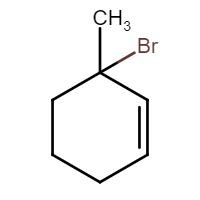
Answer
470.7k+ views
Hint: The action of NBS on an allylic halide results in the bromination of the compound on an adjacent atom. With this in mind, try to find the result of the subsequent reaction with the bulky base that is the phenolate ion.
Complete step by step answer:
Let us first look into NBS as a reagent and the properties it possesses before moving onto subsequent steps of the reaction.
N-Bromosuccinimide or NBS is a chemical reagent mostly used in reactions of Organic Chemistry such as free radical substitution, electrophilic addition, and electrophilic substitution reactions. NBS is a very convenient source of the Br•, which is the bromine free radical.
NBS reacts with doubly saturated organic compounds i.e. alkenes in aqueous solvents to give bromohydrins. The preferred conditions for this reaction requires the portion-wise addition of NBS to a solution of the alkene in 50% aqueous DMSO, DME, THF, or tert-butanol at 0 °C (which are all non-polar organic solvents). This results in the formation of a bromonium ion and the immediate attack of water which follows the initial step results in the production of a strong Markovnikov product and anti-stereochemical selectivity.
Therefore, from this we can conclude that product (B) is 3-methyl-3-bromo cyclohexene, the structure of which is given by:

Analysing the second step of the reaction, we realise that a Hoffman elimination product must be formed with the bulky base that is the phenolate ion.
The Hofmann elimination is an elimination reaction of an amine where the least stable alkene, the Hofmann product, is formed. This tendency, known as the Hofmann alkene synthesis rule, is in contrast to most normal elimination reactions, where Zaitsev's rule predicts the formation of the most stable alkene on the basis of how substituted the resultant alkene is.
Therefore, we can conclude that the final product formed would be Methylene cyclohex-2-ene, the structure of which is given by:

Thus, we can conclude that the answer to this question is a).
Note: Conventional elimination reactions that occur via the E2 mechanism follow Zaitsev’s rule. The major product will be the more substituted alkene (that is, the alkene with the most carbons directly attached to the alkene).
Complete step by step answer:
Let us first look into NBS as a reagent and the properties it possesses before moving onto subsequent steps of the reaction.
N-Bromosuccinimide or NBS is a chemical reagent mostly used in reactions of Organic Chemistry such as free radical substitution, electrophilic addition, and electrophilic substitution reactions. NBS is a very convenient source of the Br•, which is the bromine free radical.
NBS reacts with doubly saturated organic compounds i.e. alkenes in aqueous solvents to give bromohydrins. The preferred conditions for this reaction requires the portion-wise addition of NBS to a solution of the alkene in 50% aqueous DMSO, DME, THF, or tert-butanol at 0 °C (which are all non-polar organic solvents). This results in the formation of a bromonium ion and the immediate attack of water which follows the initial step results in the production of a strong Markovnikov product and anti-stereochemical selectivity.
Therefore, from this we can conclude that product (B) is 3-methyl-3-bromo cyclohexene, the structure of which is given by:

Analysing the second step of the reaction, we realise that a Hoffman elimination product must be formed with the bulky base that is the phenolate ion.
The Hofmann elimination is an elimination reaction of an amine where the least stable alkene, the Hofmann product, is formed. This tendency, known as the Hofmann alkene synthesis rule, is in contrast to most normal elimination reactions, where Zaitsev's rule predicts the formation of the most stable alkene on the basis of how substituted the resultant alkene is.
Therefore, we can conclude that the final product formed would be Methylene cyclohex-2-ene, the structure of which is given by:

Thus, we can conclude that the answer to this question is a).
Note: Conventional elimination reactions that occur via the E2 mechanism follow Zaitsev’s rule. The major product will be the more substituted alkene (that is, the alkene with the most carbons directly attached to the alkene).
Recently Updated Pages
Identify the feminine gender noun from the given sentence class 10 english CBSE

Your club organized a blood donation camp in your city class 10 english CBSE

Choose the correct meaning of the idiomphrase from class 10 english CBSE

Identify the neuter gender noun from the given sentence class 10 english CBSE

Choose the word which best expresses the meaning of class 10 english CBSE

Choose the word which is closest to the opposite in class 10 english CBSE

Trending doubts
How do you graph the function fx 4x class 9 maths CBSE

Fill the blanks with the suitable prepositions 1 The class 9 english CBSE

Which are the Top 10 Largest Countries of the World?

A rainbow has circular shape because A The earth is class 11 physics CBSE

Change the following sentences into negative and interrogative class 10 english CBSE

The Equation xxx + 2 is Satisfied when x is Equal to Class 10 Maths

Give 10 examples for herbs , shrubs , climbers , creepers

Difference between Prokaryotic cell and Eukaryotic class 11 biology CBSE

One Metric ton is equal to kg A 10000 B 1000 C 100 class 11 physics CBSE





